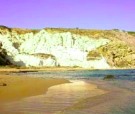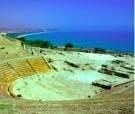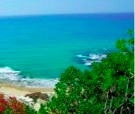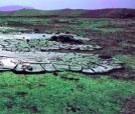|
|
 |
I PARCHI LETTERARI "IN THE DIMENSION OF THE JOURNEY"
- THE SEA: THE NATURE RESERVES
The Platani River Outlet Oriented
Nature Reserve
A site of natural beauty, the first stop for many
migratory birds arriving from Africa; thanks to the
diversified environments, it offers refuge to a
luxuriant and variegated flora, and therefore a rich and
composite avifauna. The reserve encompasses the final
portion of the Platani River and the long, sandy stretch
of Borgo Monsignore, featuring a sand bar of low dunes.
The river (called Halycus in ancient times), is
one of the most important in Sicily, the 5th longest
river on the island.
At the peak of Capo Bianco, among the candid rocks that
sparkle with miniscule chalk crystals, are the Greek
ruins of Eraclea Minoa, an ancient Selinuntine
colony from the 6th Century B.C.
 “I
arrived at the Platani river, known to the ancients as
Halycus, among the largest in Sicily and difficult to
cross during winter, since it has no bridges whatsoever.
However, the water was much lower than what my guides
had led me to believe, and I crossed without obstacle.
This river was quite famous in ancient times. Later, it
was also called Eraclea, because Dorieo, one of the
Heraclides, settled in this place by virtue of the
treaty that, following Erice’s death, Heracles had
created with the Sicilians who were to remain the
rightful owners of the entire district, until one of his
descendents landed among them." “I
arrived at the Platani river, known to the ancients as
Halycus, among the largest in Sicily and difficult to
cross during winter, since it has no bridges whatsoever.
However, the water was much lower than what my guides
had led me to believe, and I crossed without obstacle.
This river was quite famous in ancient times. Later, it
was also called Eraclea, because Dorieo, one of the
Heraclides, settled in this place by virtue of the
treaty that, following Erice’s death, Heracles had
created with the Sicilians who were to remain the
rightful owners of the entire district, until one of his
descendents landed among them."
Eraclea Minoa by Friederich Munter.
ERACLEA MINOA, is an ancient colony, perhaps of
Mycenean origin, located 15 km from Siculiana. Its
enchanting geographic position makes it one of the most
beautiful archaeological sites in Sicily. Some fragments
uncovered in the archaic necropolis of the 6th Century
B.C. would date its origins to
 the
Neolithic period, while the most ancient coins testify
to the presence of a Phoenician colony. In documents the
city is referred to by three different names: Macara, in
other words “city of Makar”, the Phoenician Heracles;
Minoa, which according to legend was founded by the King
of Crete, Minos, who had followed Dedalus here; and
Eraclea, a Spartan colony_(see Fazello and
Cluver). the
Neolithic period, while the most ancient coins testify
to the presence of a Phoenician colony. In documents the
city is referred to by three different names: Macara, in
other words “city of Makar”, the Phoenician Heracles;
Minoa, which according to legend was founded by the King
of Crete, Minos, who had followed Dedalus here; and
Eraclea, a Spartan colony_(see Fazello and
Cluver).
After the Phoenicians and the Spartans, it became a
sub-colony of Selinunte in the 5th Century B.C. and it
reached its zenith of urban development during the
Hellenic period. It passed from Greek control to the
Carthaginians several times, until 210 B.C., when it was
conquered by the Romans. It was then abandoned in the
1st Century B.C.
The Torre Salsa Oriented Nature
Reserve
 Approximately
15 km from Agrigento, just beyond Capo Siculiana, at the
easternmost point of the unending beach that runs along
the eastern shore of the chalky promontory of Capo
Bianco, is the Torre Salsa Nature Reserve. A variety of
habitats alternate among a sandy coastline, dunes, lakes
and Mediterranean maquis, allowing for an abundant
presence of animal life: foxes, porcupines, weasels,
wild rabbits, falcons and buzzards in the innermost
area; aquatic and riparian birds along the coastal zones.
More than six kilometres of beaches that extend from
Capo Bianco to Siculiana Marina are perhaps still one of
the few places where the endangered loggerhead sea
turtle (Caretta Caretta) is still able to reproduce. The
central portion of the coastline, is interrupted by the
outlet from the small Salso river (which gives the
reserve its name), which after approximately 3
kilometres of dunes that are covered by a xerophile
vegetation and a dense maquis, results in a small morass,
a source of nutrition for many limiculous birds. Approximately
15 km from Agrigento, just beyond Capo Siculiana, at the
easternmost point of the unending beach that runs along
the eastern shore of the chalky promontory of Capo
Bianco, is the Torre Salsa Nature Reserve. A variety of
habitats alternate among a sandy coastline, dunes, lakes
and Mediterranean maquis, allowing for an abundant
presence of animal life: foxes, porcupines, weasels,
wild rabbits, falcons and buzzards in the innermost
area; aquatic and riparian birds along the coastal zones.
More than six kilometres of beaches that extend from
Capo Bianco to Siculiana Marina are perhaps still one of
the few places where the endangered loggerhead sea
turtle (Caretta Caretta) is still able to reproduce. The
central portion of the coastline, is interrupted by the
outlet from the small Salso river (which gives the
reserve its name), which after approximately 3
kilometres of dunes that are covered by a xerophile
vegetation and a dense maquis, results in a small morass,
a source of nutrition for many limiculous birds.
The splendid crystalline sea, with its graduated sea
floor and cold waters that are rich with fish from the
canal of Sicily, make this place one of the few strips
of unspoiled nature in Sicily.
The Macalube di Aragona
Integral Nature Reserve
 The
Reserve was recently created due to the presence of a
particular geologic phenomenon. The entire area is
covered with an infinite amount of small clay cones (Malacube)
that emit a muddy mixture of methane gas and saltwater.
This is the exterior manifestation of some hydro-clay
springs, these little volcanoes, that take their name
from the Arab word “maql¨b”, meaning the earth’s turmoil,
continue to appear and disappear from the ground,
varying in number and size and giving the landscape an
almost lunar appearance. The
Reserve was recently created due to the presence of a
particular geologic phenomenon. The entire area is
covered with an infinite amount of small clay cones (Malacube)
that emit a muddy mixture of methane gas and saltwater.
This is the exterior manifestation of some hydro-clay
springs, these little volcanoes, that take their name
from the Arab word “maql¨b”, meaning the earth’s turmoil,
continue to appear and disappear from the ground,
varying in number and size and giving the landscape an
almost lunar appearance.
ARAGONA
Located fifteen kilometres from Agrigento, the town was
given the name Aragona by its founder, Count Baldassare
Naselli da Comiso who wanted to pay tribute to his
mother, Beatrice Aragona Branciforti. In 1615, Luigi
Naselli was granted the title of Prince of Aragon by the
sovereign, Philip IV. The noble Naselli family has been
associated with ruling of this town until 1812, the year
that the feudal system was abolished there.
|



